This CE Center article is no longer eligible for receiving credits.
This course is part of the Natural Stone Academy
One of the greenest building materials available is natural stone, especially when sustainable extraction practices are considered. The material itself is taken straight out of the earth from quarries. From there, it is cut to size, finished, and installed as everything from countertops and flooring to fireplace mantles, backsplashes, walkways, garden walls, and exterior cladding. Stone is low maintenance, easy to clean, and can offer a long lifetime of protection, beauty, and service, making it an ideal material for green building projects. Dimension stone is natural rock that has been quarried in prespecified block or slab sizes and finished to certain specifications and requirements.

All images courtesy of MIA+BSI: The Natural Stone Institute
Houston Museum of Natural Science
Exterior cladding made from natural stone can offer both an aesthetic beauty and sustainable surface to the building, and the anchorage system holding the material in place is a critical feature.
Introduction to Natural Stone and Anchorage Systems
Today, one ideal use for natural stone is in exterior cladding. Whether it is used to help reduce a building’s heat island effect in a hot and dry climate, or to provide a water- and freeze-resistant exterior in a colder climate, exterior stone cladding is versatile and appealing. The raw and authentic appeal of stone lends itself to bold and interesting design options, while also satisfying the structural needs of the building.
Natural stone cladding requires a safe, secure, and durable anchoring system. When used as a cladding, the weight of the stone is subject to several forces that it must be able to resist—namely gravity, wind pressure, and seismic loads. To ensure a safe and durable stone cladding project, architects need to understand how natural stone anchorage systems work, what key components are involved, and how to work with engineers and installers.

Northwestern University Bienen School of Music, Evanston, Illinois
Whether inside in a protected environment or outside, the forces of nature are constantly working against cladding, making anchorage systems a critical safety and sustainable element of design.
Forces that Impact Natural Stone Anchorage Systems
Forces such as gravity, wind load, and seismic activity all can negatively impact natural stone cladding and anchorage systems if the building team does not consider the potential impact of these forces. One of the best ways to ensure success is to hire an accredited stone installer to work with the project’s structural engineer and architect. These team members are better suited for understanding the specific needs of the anchorage system and can ensure the final product remains structurally sound for years to come.
With that in mind, let’s take a look at how nature impacts stone cladding, and how choosing natural stone as a cladding material inherently brings strength and durability to a project.
The Inherent Qualities of Natural Stone
As a natural product, stone is inherently eco-friendly. While it needs to be cut and finished, the material itself is “ready made” right out of the earth. Stone is naturally very strong, durable, and easy to maintain. When best practices are used for extraction and manufacturing, natural stone is considered one of the most sustainable products available.
As a dense, strong, and durable product, natural stone works well as an exterior cladding. However, in order for the cladding to be safe and secure, it needs to literally be safely secured to the building structure by anchorage systems that can withstand the forces that impact natural stone cladding.
Forces that Impact Natural Stone Cladding
Stone cladding panels will be subjected to gravity and to applied loads, such as wind load, thermal movement, and seismic movement—anything that impacts the building’s structure. The three primary forces that can affect the safety and security of natural stone cladding are gravity, wind load, and seismic load.
Gravity is an obvious force and is best understood by considering the very physical characteristic of stone as a heavy material. Gravity is a vertical force, and it is proportional to the mass of an object—in this case, a stone panel. The heavier the stone, the more work the anchor needs to do to secure it to the structure.
Wind load is a slightly more complicated concept than gravity, and it is much more complicated to predict and protect against. When wind encounters a building, it exerts pressure on the walls—and thus the cladding. This pressure can be both positive, with the wind pushing directly on the cladding, or negative, with the wind pulling outward on the wall, or essentially “sucking” the cladding. In most cases, negative wind loads on buildings tend to be stronger than positive loads. Corners and areas with raised or lowered surfaces typically experience the highest loads. The pressure that is put on the cladding depends on the building design. Wind loads are expressed in terms of pressure, either in pounds per square foot (lbs/ft2) in U.S. customary units, or in pascals (Pa) in SI units.
With dimension stone cladding, the wind loads will always be proportional to the area of the stone panel. This means that a strong wind on a large panel will exert more force than the same wind on a smaller panel. In cases with negative wind pressure, force on the stone can act in inverse, creating suction. Depending on the geometry of the anchor clip design, in some cases, wind loads can exert forces on the anchor clips that are cumulative with the gravity forces. This is always the case when negative wind loads are experienced by soffit stones. A building’s size, shape, height, location, and neighboring buildings all can influence wind loads.
Seismic loads stem from earthquakes and aftershocks, and they are unquestionably the most complicated loads to determine since the load can be both perpendicular and parallel to the face of the stone. As with gravity, this load is also proportional to the mass of the stone panel. Because seismic activity is not usually associated with high-wind events, standard building codes rarely require that building design consider a combination (or cumulative) load of seismic and wind loads. That said, in cases where forces perpendicular to thin stone cladding faces are expected, the wind loads in most cases will be greater than potential seismic loads, and thus will govern most design decisions.
Building codes for seismic loading vary among locations. Some regions are prone to significantly strong earthquakes, which can exert extreme force on the buildings and the exterior cladding. Compared to regions where earthquakes are infrequent, these buildings will have much higher seismic load requirements. These requirements are determined by the probability of seismic action and the maximum possible intensity of the quake.
Regardless of the type of load, designers and builders need to understand how the actual load path works for natural stone cladding and ultimately how different loads affect that path. Load paths are foundational to structural engineering, and they consist of two distinct phases: first, building professionals must identify and quantify the loads; second, they must understand how that load gets transferred downward to the ground. These calculations are typically done by the structural engineer, not the architect.

Tarrant County Civil Courthouse, Fort Worth, Texas
When installing exterior natural stone cladding, to ensure safety and durability, each piece of the load path is important, and building professionals should understand how each works individually, as part of the building system, and in response to the various forces.
As noted above, the three natural forces that impact natural stone cladding are gravity, wind load, and seismic load. On the most basic level, the load path begins with the individual stone panel, and it is transferred through the anchor to the building structure and frame, down to the foundation and footings, and eventually down to solid ground. Each piece of the path is important, and building professionals should understand how each works individually, as part of the building system, and in response to the various forces. The stone panel, the anchor, and the connection to the building are usually the three components for which the stone installers are responsible; however, they should plan to work closely with contractors to ensure that the entire system is safe and secure.
Designing to Withstand the Forces of Nature: Anchorage Systems
Anchors, which secure dimension stone to the building frame, are critical to the safety and durability of a building’s external cladding. The anchorage systems must be chosen or designed to meet the specific needs of each individual project; anchors are definitely not “one size fits all” so each project needs to be engineered and designed based on the elements that affect the specific building.
From a structural standpoint, the stone panel is best thought of as a beam. That is, it receives a uniform load along its span, and it carries that load to the anchor points. These anchor points are usually found along the stone panel’s perimeter. When the panel resists the load, it experiences flexural stress within the panel itself; design engineers responsible for this aspect of the project must make sure that the flexural stress of the stone panel does not exceed the allowable flexural stress. This allowable stress load can be calculated by dividing the flexural strength by the appropriate factor of safety for the specific project.
Three factors affect stone panels experiencing flexural stress: load, span, and depth (stone thickness). First, greater, or heavier, loads will result in increased stress within the stone panel. For example, a high negative wind load that creates suction on a stone panel face during a storm will increase the stress compared to a low-wind situation. The panel’s span between supports also affects the stress. Increasing the distance between the anchor points (i.e., the span) does two things. First, it increases the bending stresses of the stone panel; second, it increases the area. This increase in area in turn increases the total load: doubling the span quadruples the stress, giving it a “squared” relationship. Finally, the thickness of the stone is comparable to the depth of a beam. It also has a squared relationship to stress; doubling the thickness of the stone reduces the stress by a factor of four.
Anchorage Systems and Performance
There are many types of anchorage systems available, ranging from custom-designed devices for specific projects to standard, commercial options.

Pictured is a combination gravity and lateral-load anchorage using welded stainless steel anchors.
The anchor system connects the stone unit to the building’s framing, and thus is the next critical piece of the load path. Often the anchor consists of multiple components to fasten the stone panel to the frame. Improperly designed, manufactured, or installed anchor systems are common failure points, often resulting in fractured stone around the anchor prep cut.
Anchors have three key load transition points: the junction between the stone and the anchor, the anchor itself, and the physical connection between the anchor and the building frame. Anchors can be attached to the stone panel in a variety of ways, depending on the project and stone type. A “prep cut,” or kerf, is machined into the stone panel. The most common types are a hole, a “plunge cut” kerf, a kerf of a determined distance, and a continuous kerf.
In order to protect against potential failure, installers should make sure that the anchor tab is properly sized and, if possible, longer than needed to improve the strength of the connection with the stone panel.
Some situations will call for one type of anchor, while others require another, depending on the load path. For example, the anchorage needs of a load-bearing clip (or shelf) angle, where gravity is the primary load force, will be very different from a situation where positive or negative wind load (plus gravity) affect the panel.
Anchors can be connected to the building frame with a variety of techniques, depending on the material to which they are being anchored. Expansion anchors, for example, can be installed into concrete, and other anchors may be welded to hardware embedded in the concrete. If the frame is steel, anchors may be welded or bolted. Lighter-gauge metal frames may have self-drilling or self-threading fasteners installed as anchors. This connection is the last piece of the load path for which stone installers are usually responsible.
Collaboration Between Project Building Professionals
One of the biggest mistakes that architects may make when considering natural stone cladding is to fail to consult cladding engineers or facade consultants at the start of the project. A cladding engineer and/or cladding architect can review the architectural details of the project and help ensure that the proposed cladding and anchorage systems are compatible both with each other as well as with the rest of the project specifications.

Early communication with a facade consultant can help avoid any problems further along in the project and ensure successful installation.
Structural engineers will almost certainly be involved as engineer of record (EOR) to assess the project for potential seismic and wind loads; consequently, they will be interested in the cladding anchorage system and how it impacts the structural load. In many cases, the EOR may not be familiar with the cladding system or how it impacts the structural load, and so early communication with a facade consultant can help avoid any problems further along in the project.
Whenever possible, architects should hire Marble Institute of America (MIA) accredited stone installers to consult on the project (and to perform the installation), and they should be responsible for designating the anchorage system. Most installers work with many different systems and different stones, and thus can help determine the most appropriate system for the project. Good practice includes providing performance specifications at the start of the project, making sure that shop drawings and anchorage calculations are always required; the specs can help the rest of the team be more confident in the anchorage system.
Anchorage Types
The main purpose of anchorage systems is to attach the stone to the frame. To be successful, such systems must resist both lateral and gravity loads. Consequently, the best anchors generally are the simplest and designed with the fewest components, and thus the fewest potential failure points. Anchors are also carefully designed to prevent galvanic corrosion, both of which can cause the anchors to fail years after they have been installed.

Clip or shelf angle anchors work by supporting the stone’s dead load via short, thick L-shaped metal clips.
Clip or shelf angle anchors work by supporting the stone’s dead load via short, thick L-shaped metal clips. The vertical leg of the section is anchored into the building frame, and the horizontal leg supports the stone cladding.
Shelf angles are usually made of mild steel with corrosion-resistant coatings. While their primary purpose is to support against gravity, they can be modified to address multidirectional loads by adding a small clip that penetrates the kerf in the stone. If this method is used, the clips are usually stainless steel or other metals with appropriate separators. With heavier stone, an additional rebate or a kerf cut that is sawn to form a slot may be cut into the bottom edge of the stone to provide full movement function of the joint.

Bent stainless plates are ideal for projects where corrosion may weaken the anchorage system.

A variation on the bent stainless steel plate is a welded plate.
Some projects call for high corrosion resistance, and in such cases, bent stainless plate anchors combined with stainless steel shelf angles can be a good choice. These anchors, also known as “welded stainless steel Ts,” are usually designed so that the stainless section is a bent plate, and the lateral load is carried via welded tabs located at the end of the plate or by separate strips of stainless steel welded to the end of the plate. An advantage to using the welded steel option is that a thinner piece of metal can be used for this portion, which allows for a smaller preparation into the stone, leaving more of the natural stone intact. Additionally, there is an increased length of engagement with stone, which is usually the weak link of the anchorage system.
As with clip angles, bent stainless plate anchors may also benefit from rebates being cut into the bottom edge of the stone panel and affixed with the stainless steel anchors. This method allows full movement capability of the joint since the anchor is not occupying any space in the joint.
Aluminum extrusions are most commonly used to help restrain gravity and lateral loads and are available in either short sections or as a continuous section. The different section lengths provide different challenges and are more appropriate for different purposes. For example, a continuous section length requires that the connections of the aluminum to the structure be carefully analyzed to minimize deformation between the connection points. If excessive deflection occurs, the anchor will only hold near the connection point and not along the rest of the span.

Strap anchors are flat metal bars that are designed to be inserted into a kerf (slot) in the edge of the stone panel.

Pictured is an example of an anchor failing due to the bolt placement too far from the bend.
Strap anchors are flat metal bars that are designed to be inserted into a kerf (slot) in the edge of the stone panel. The anchor transfers the load from the stone to the wall and must be strong enough to hold the load without losing its form. The anchor can also bend under negative lateral loads if the hole and the bend are too far; this is one of the most common misapplications of the strap anchor.
Plug anchors include two components: a threaded rod is screwed into a tapped plug that has been inserted into a round hole in the stone. This anchor type is not often used because there are less-expensive options available; however, it works very well with softer stone types, such as sandstone, in cubic thickness (greater or equal to 3 inches, or 75 millimeters). With softer stone, plug anchors are known to be significantly stronger than other types of back anchors.
Application and Material Influence on Anchorage Systems
Regardless of the anchor type, it is critical that contact between the minerals in the stone and the metal be controlled to prevent corrosion of the metal, which would compromise its strength. As noted in the descriptions of the various anchor types, these systems may be both ferrous and nonferrous, and components most often involve stainless steel or aluminum. The issue of corrosion is directly linked to the application and material influence on the anchorage system, mainly in that different stone types are more prone to moisture penetration or have mineralogy that affects the metal of the anchor more than other stone types. Consequently, installers need to consider the combination of anchorage systems and stone types in the context of specific climates and environments. For example, limestone in an arid climate will be less susceptible to corrosion than in a more humid or wet climate. Architects should be aware of possible corrosion issues and discuss the possibility with the project’s structural engineer and the stone installer before finalizing any decisions.
Some examples of problems that can happen when metal comes in contact with different types of stone are listed below. These examples can be used as a starting point for considering anchorage options for natural stone.
Calcareous stone types such as limestone and marble are prone to corrosion when in contact with certain untreated metal components. Any metal used must be coated or sheathed with a compound that does not react with the stone (or other cladding materials). Moreover, the coating must be compatible with the joint sealant. However, not all metal components are vulnerable to corrosion; for example, stainless steel types 302 and 304 can be used without any protection.

Aluminum Unitized Anchorage System
Aluminum alloys can be problematic if they come into contact with both moisture and certain stone minerals. For example, when used with calcareous or calcitic stone, aluminum can potentially corrode, even if it has first been anodized.
Corrosion can also happen if inappropriate components come in contact with siliceous stone, such as granite, and if moisture is present. As such, noncorroding materials must be used.
As the saying goes, a chain is only as strong as its weakest link, and the same holds true for anchorage systems.
Anchorage System Fill and Finish Work on Natural Stone
Anchorages for natural stone cladding typically require that the joints and surrounding spaces be allowed to accommodate movement.
Sealants can be used to weatherproof joints between the stone panels and any adjacent components. This sealant will be wet when applied, but will cure “soft,” functioning as a gasket to insulate movement and serving as a buffer between cladding elements so that forces are not transferred between the parts.
The filler material resides in the anchor prep and displaces the void between the penetrating anchor and the interior walls of the anchor prep.
Gypsum-based fillers were popular several decades ago but are no longer considered appropriate for natural stone cladding. Exterior cladding that was installed during the era of gypsum-based fillers reveals that the material has a low strength and is vulnerable to swelling or erosion if exposed to even a small bit of moisture.
The combination of gypsum-based materials with portland-based products should be avoided. The combination of the two materials will create a hybrid known as “ettringite.” Ettringite has the unusual property of having a greater volume than the sum of the two parent components, and thus expands.
Cementitious fillers, such as portland cement-based setting grouts, are common and easily available. These fillers tend to cure rapidly (often within 30 minutes) and are appropriate for many projects. That said, they may be vulnerable to swelling or erosion when exposed to moisture, and thus may be inappropriate in certain environments or for certain projects.
Resinous fillers, or adhesives, usually refer to epoxy. These fillers are more expensive than other options and typically have slow cure times. There are known problems with the high level of rigidity of epoxies in their cured state, which has been associated with increased stresses near the anchor prep as a result of limited flexibility. These factors make epoxy appropriate for certain anchorage systems, but not others. For example, they are safe for securing dowels in cubic stone sections, such as stairs pieces, which are supported by the structure below, but they are not appropriate for thin stone cladding, where the requirements for a flexible connection come into play.
Elastomeric fillers, such as silicone and polyurethane sealants, are popular choices for filling anchor preps in part because they are flexible in their cured state and allow for dynamic movement within the anchorage system. This characteristic is beneficial for projects where the stone cladding may require very flexible connections.

Pictured is an example of bent stainless steel shapes installed in stone cladding.
Shims work as physical spacers. They are typically made of either stainless steel or the more popular high-density, high-impact plastic. Regardless of whether the shim is made of stainless steel or plastic, it must be able to bear the load without deforming. In some cases, shims are used to provide additional support, while other types of fillers cure, after which the shims are removed.
The Future of Anchorage Systems
As the building industry continues to “go green,” anchorage systems will follow the trend, especially as new materials are put into use. One change on the horizon is low- or zero-VOC chemical anchors as an alternative to traditional adhesives. Eliminating volatile organic compounds in chemical-based anchors and adhesives is particularly important for interior installations, and the change can positively affect awarded LEED credits. Another modification to chemical adhesives is an “improved UV stability” designation. Any adhesive material that is exposed to sunlight is also exposed to UV radiation, and over time the adhesive will change color. Newer products will minimize or eliminate this problem.
Two other areas of innovation are in the cure rates of adhesives and improved delivery systems. Many new adhesives now cure much more quickly than traditional options. The trend is toward strong adhesives that cure quickly and safely. Meanwhile, other companies are exploring ways to improve how the adhesive is mixed and dispensed, with the aim of reducing waste. For example, an improved trigger mechanism on the adhesive gun makes it easier to squeeze, which results in less wasted material.
Conclusion
In conclusion, one of the most important takeaway messages for architects considering using natural stone exterior cladding is that they must work closely with the structural engineer for material and anchorage decisions, and they must include accredited specialists in the process from the very start of the project. There are many methods used for anchoring dimension stone, and the components for each vary. Moreover, the installation of the cladding is only one of the many elements of a complete wall system. Every component of the wall must be considered when deciding which anchorage system will be best for the project. For example, building professionals must first select a structurally viable building stone for their respective project before they even think about choosing an anchorage system. If for some reason test data for the stone isn’t current or reliable, they must plan to test the stone before selecting it. Once this is done, they can determine the panel size and thickness that best complements the physical characteristics of the stone.
Only after these tasks are complete should they choose an anchoring system that is prescriptively designed by the architect or contractor, or the architect can specify a proprietary panelized system. If the architect specifies a system, they must shoulder the risk and responsibility of the choice. A good team that includes a structural engineer and a stone installer is critical for the success of the project.
Andrew A. Hunt, vice president of Confluence Communications, has 16 years of experience in green building and has produced more than 100 educational and technical publications. confluencec.com

|
MIA+BSI: The Natural Stone Institute offers a wide array of technical and training resources, professional development, regulatory advocacy, and networking events for the natural stone industry. www.naturalstoneinstitute.org/stoneacademy
|


























